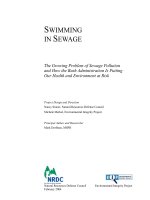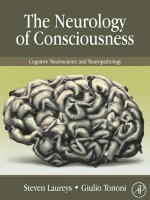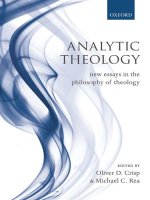- Trang chủ >>
- Khoa Học Tự Nhiên >>
- Vật lý
inventing gods law how the covenant code of the bible used and revised the laws of hammurabi sep 2009
Bạn đang xem bản rút gọn của tài liệu. Xem và tải ngay bản đầy đủ của tài liệu tại đây (3.65 MB, 604 trang )
INVENTING GOD’S LAW
This page intentionally left blank
INVENTING GOD’S LAW
How the Covenant Code of the Bible Used and
Revised the Laws of Hammurabi
David P. Wright
1
2009
9 8 7 6 5 4 3 2 1
Printed in the United States of America
on acid-free paper
1
Oxford University Press, Inc., publishes works that further
Oxford University’s objective of excellence
in research, scholarship, and education.
Oxford New York
Auckland Cape Town Dar es Salaam Hong Kong Karachi
Kuala Lumpur Madrid Melbourne Mexico City Nairobi
New Delhi Shanghai Taipei Toronto
With offices in
Argentina Austria Brazil Chile Czech Republic France Greece
Guatemala Hungary Italy Japan Poland Portugal Singapore
South Korea Switzerland Thailand Turkey Ukraine Vietnam
Copyright © 2009 by Oxford University Press, Inc.
Published by Oxford University Press, Inc.
198 Madison Avenue, New York, New York 10016
www.oup.com
Oxford is a registered trademark of Oxford University Press.
All rights reserved. No part of this publication may be reproduced,
stored in a retrieval system, or transmitted, in any form or by any means,
electronic, mechanical, photocopying, recording, or otherwise,
without the prior permission of Oxford University Press.
Library of Congress Cataloging-in-Publication Data
Wright, David P. (David Pearson), 1953–
Inventing God's law : how the covenant code of the Bible used
and revised the laws of Hammurabi / David P. Wright.
p. cm.
Includes bibliographical references and indexes.
ISBN 978-0-19-530475-6
1. Bible. O.T. Exodus XX, 23–XXIII, 19—Criticism, interpretation, etc.
2. Code of Hammurabi. 3. Bible. O.T.—Extra-canonical parallels.
4. Law, Ancient—Sources. 5. Law—Middle East—Sources. I. Title.
BS1245.52.W75 2009
222'.12066—dc22 2009012890
For Dianne
This page intentionally left blank
It was by accident that the thesis of this book came to be. I had accepted and
operated according to the standard critical understanding of the Covenant Code
and its relationship to Mesopotamian legal tradition. This viewed the biblical
law collection as the result of stages of development over several centuries.
The similarities it had with texts such as the Laws of Hammurabi were due to
Israel’s and the Bible’s inheriting oral traditions that circulated in Syria and
Canaan before Israel appeared on the historical scene. I assumed, too, that the
laws of the Covenant Code in large part reflected the practice of early Israel.
Then, one day in the fall of 1998 while preparing a lecture for a course on
biblical and Near Eastern law at Brandeis University, I noticed that passages
from the Covenant Code and the Laws of Hammurabi that I had assigned for
an upcoming class session on a new topic happened to follow, in sequence,
passages in these texts that I had assigned from the previous class session that
was devoted to a different topic. I spent the next several hours looking for
other sequential correlations between the two collections. By dinner time, I had
charted a list of ten such laws or legal topics. Thus this study was born.
Since that day, I have spent time testing, expanding, questioning, and refin-
ing the evidence and arguments. My first paper on the topic was at the New
England Regional Meeting of the Society of Biblical Literature, April 1999
(Newton, Massachusetts). Since then, I have reported on my findings at various
national and international professional meetings. I also published preliminary
versions of my findings in three articles, the first in Maarav (“The Laws of
Preface
viii Preface
Hammurabi as a Source for the Covenant Collection,” 2003, appeared 2004) and
two in the Zeitschrift für altorientalische und biblische Rechtsgeschichte (“The
Compositional Logic of the Goring Ox and Negligence” and “The Fallacies
of Chiasmus,” 2004). These early publications sought to elicit response from
colleagues. One such considered response, by Bruce Wells, allowed me in
turn to restate and sharpen the presentation of the data in a second Maarav
article (“The Laws of Hammurabi and the Covenant Code: A Response to
Bruce Wells,” 2006, appeared 2007). Some material from these articles has
been incorporated, with extensive revision, at places in this study. I thank these
journals for permission to reuse this material.
The thesis of this book requires detailed textual examination and is there-
fore by necessity technical in nature. In order to facilitate a basic grasp of the
evidence, to serve nonspecialists as well as specialists who want an overview, I
have summarized the thesis and evidence in chapter 1. Reading this along with
the conclusion (chapter 13) will give any reader a solid understanding of the
study’s claims. A more intensive reading would include chapters 2–4 (part I),
which lay out in detail the evidence for the Covenant Code’s dependence
upon Hammurabi’s Laws and explain when this borrowing occurred. A fully
engaged reading would add chapters 5–12 (part II). They describe how the
Covenant Code transformed its sources and explain the purpose and ideology
of the work. At the suggestion of colleagues, I have provided in most cases cita-
tions of texts in translation and in the original languages to allow immediate
critical analysis. I have also included translations of citations from contempo-
rary European scholarship in the main text of the chapters (and in the notes of
chapter 1) for the benefit of nonspecialists.
I am deeply grateful to several colleagues for their help and criticism:
Bernard Levinson, for taking an early interest in my findings, responding to
drafts of some of my papers on the book’s thesis, critiquing and refining some
of my arguments in his own publications, and sharing his offprints and some
prepublication manuscripts; Jeffrey Stackert, my student during the years that
this study was in formation and from whom I learned much, for providing a
critical ear in hours of discussion and evaluating some early drafts of chapters;
my Brandeis colleague Tzvi Abusch, for being an incisive sounding board for
ideas, helpful with Assyriological matters, and an advisor on how to present the
data and arguments on such a complicated topic; Bruce Wells, for his resistance
and criticisms, not only in his review article, just noted, but in friendly discus-
sions over the past few years, which have helped me see a wider set of ques-
tions; Bernard Jackson, for corresponding with me about my first articles and
sharing the prepublication proofs of his now recently published book, Wisdom-
Laws; Eckart Otto, for sharing his work with me over the years and for recently
facilitating the presentation of my ideas in ZABR; William Morrow, for his
cautionary questions and sharing a manuscript of a forthcoming article; Simo
Parpola, for asking me to summarize my thesis for his online Melammu Project
(see Wright, “The Codex Hammurapi as a Source for the Covenant Collection”);
Preface ix
and John Van Seters, for sending me offprints of his articles and discussing his
approach and views with me.
In addition, I thank other scholars for suggesting references, engaging in
discussions, and offering critiques, including Joel Baden, Simeon Chavel,
Andrew Cohen, Tikva Frymer-Kensky, Samuel Greengus, Dale Patrick, Jan
Wagenaar, Emily West, and Raymond Westbrook. I acknowledge several of my
Brandeis colleagues for their critique and suggestions, including Marc Brettler,
Bernadette Brooten, Jonathan Decter, Jon Levisohn, Antony Polonsky, and
Eugene Sheppard. I also thank the several students who served as research
assistants on this work in its various stages: David Bokovoy, Jason Gaines, and
Michael Singer. I also recognize a debt to other graduate students who have
argued with me and provided suggestions, including Molly DeMarco, James
Getz, Eric Grossman, Alan Lenzi, Sarah Shectman, Sheila Reeder, Susan
Tanchel, and Ilona Zsolnay.
I thank the British Museum and cuneiform collection curator Jonathan
Taylor for allowing me to examine and photograph unpublished neo-Assyrian
fragments of Hammurabi’s Laws (see chapter 4, n. 137).
Finally, I extend special gratitude to my wife, Dianne, who supported me
through the long process of developing this study, listened to my incessant and
evolving test lectures, and endured the various grunts and groans of the writing
process. She has always been patient and accommodating. Since 1998, our four
children have gone through and graduated from college, and I thank them, too,
for being patient with a sometimes preoccupied father. Dianne and I are now
happy to see this fifth “child” leave the nest.
This page intentionally left blank
Abbreviations and Special Terminology xiii
1. Introduction: The Basic Thesis and Background 3
Part I: Primary Evidence for Dependence: Sequential
Correspondences and Date
29
2. The Casuistic Laws 31
3. The Apodictic Laws 51
4. Opportunity and Date for the Use of Hammurabi’s and
Other Cuneiform Laws 91
Part II: The Compositional Logic of the Covenant Code 121
5. Debt-Slavery and the Seduction of a Maiden
(Exodus 21:2–11; 22:15–16) 123
6. Homicide, Injury, Miscarriage, and Talion
(Exodus 21:12–14, 18–27) 154
7. Child Rebellion, Kidnapping, Sorcery, Bestiality, and Illicit
Sacrifice (Exodus 21:15–17; 22:17–19) 192
8. The Goring Ox and Negligence (Exodus 21:28–36) 205
9. Animal Theft, Crop Destruction, Deposit, and Burglary
(Exodus 21:37–22:8) 230
10. Animal Injury, Death, and Rental (Exodus 22:9–14) 265
Contents
xii Contents
11. The Themes and Ideology of the Apodictic Laws
(Exodus 20:23–26; 21:1; 22:20–23:19) 286
12. Redactional Growth in the Apodictic Laws and the
Covenant Code’s Relationship to the Exodus Narrative 322
13. Conclusions 346
Notes 365
Bibliography 511
Author Index 553
Subject Index 561
Text Reference Index 569
xiii
Abbreviations otherwise follow those found at the beginning of the volumes
of the Anchor Bible Dictionary, supplemented by those in The Assyrian
Dictionary of the Oriental Institute of the University of Chicago.
BZABR (= BZAR) Beihefte zur Zeitschrift für altorientalische und bib-
lische Rechtsgeschichte
CC Covenant Code (20:23–23:19)
CCN Covenant Code Narrative (see chapter 12)
CDA Black, Jeremy, Andrew George, and Nicholas
Postgate. A Concise Dictionary of Akkadian. Santag:
Arbeiten und Untersuchungen zur Keilschriftkunde 5.
Wiesbaden: Harrassowitz, 1999.
COS The Context of Scripture. Edited by William W. Hallo
and K. Lawson Younger Jr. 3 vols. Leiden: Brill, 2003.
Exhortatory Block Cols. 47:59–48:94 of LH (see chapters 1 and 3)
HALOT Koehler, Ludwig; Walter Baumgartner; Johann Jakob
Stamm, eds. M. E. J. Richardson, trans. and ed. The
Hebrew and Aramaic Lexicon of the Old Testament.
Study Edition. Leiden: Brill, 2001.
HL Holiness Legislation (see chapter 13, n. 19)
HtL Hittite Laws
JHebS Journal of Hebrew Scriptures
Abbreviations and Special Terminology
xiv Abbreviations and Special Terminology
LE Laws of Eshnunna
LH Laws of Hammurabi
LLI Laws of Lipit Ishtar
LU Laws of Ur-Namma
MAL Middle Assyrian Laws
NA Neo-Assyrian
NBL Neo-Babylonian laws
OB Old Babylonian
OBC Orientalia Biblica et Christiana
OEANE Oxford Encyclopedia of Archaeology in the Near East
SAA State Archives of Assyria
SAAS State Archives of Assyria Studies
String I Exodus 22:20–30 (see chapters 1 and 3)
String II Exodus 23:9–19 (see chapters 1 and 3)
VTE Vassal Treaties of Esarhaddon (see Parpola and Watanabe,
Neo-Assyrian Treaties)
ZABR (= ZAR) Zeitschrift für altorientalische und biblische
Rechtsgeschichte
INVENTING GOD’S LAW
This page intentionally left blank
3
1
Introduction: The Basic Thesis
and Background
This study proposes a profoundly new understanding of the composition and
nature of the Covenant Code (Exodus 20:23–23:19).
1
It contends that this law
collection, the pinnacle of the revelation at Mount Sinai according to the story
of Exodus 19–24, is directly, primarily, and throughout dependent upon the
Laws of Hammurabi. The biblical text imitated the structure of this Akkadian
text and drew upon its content to create the central casuistic laws of Exodus
21:2–22:19, as well as the outer sections of apodictic law in Exodus 20:23–26
(along with the introduction of 21:1) and 22:20–23:19.
2
This primary use of the
Laws of Hammurabi was supplemented with the occasional use of material
from other cuneiform law collections and from native Israelite-Judean sources
and traditions. The time for this textual borrowing was most likely during the
Neo-Assyrian period, specifically sometime between 740 and 640 BCE, when
Mesopotamia exerted strong and relatively continuous political control and cul-
tural sway over the kingdoms of Israel and Judah, and a time when the Laws of
Hammurabi were actively copied in Mesopotamia as a literary-canonical text.
The Covenant Code also appears to be a unified composition, given the influ-
ence of Hammurabi’s laws throughout, the thematic integrity resulting from
this, the unique scribal talents and interests necessary for the text’s compo-
sition, and its temporal proximity to the basic laws of Deuteronomy, which
depend on the Covenant Code’s laws and date not much later, probably to the
latter half of the seventh century. Moreover, because the Covenant Code is
largely a creative rewriting of Mesopotamian sources, it is to be viewed as
4 Inventing God’s Law
an academic abstraction rather than a digest of laws practiced by Israelites
and Judeans over the course of centuries. Its selective character and the man-
ner in which it reshapes the political and theological landscape of the Laws of
Hammurabi, in fact, make it appear to be preeminently an ideological docu-
ment, a response to Assyrian political and cultural domination.
This model differs decidedly from current critical scholarly appraisals of
the text.
3
According to these, the Covenant Code’s similarities with ancient
Near Eastern law—perceived only imperfectly until now—are due to general
or specific traditions, preserved orally and reflected in inherited legal prac-
tice, that reach back into the second millennium
BCE. One model proposes that
Mesopotamian customs became known in Syria-Canaan through the establish-
ment of cuneiform scribal schools in this western region during the mid- to
later second millennium. These were then handed on primarily in oral form
into the first millennium, at which time the people of Israel took them over,
practiced them, and encoded them in law. An alternate model proposes that the
customs go back earlier to the beginning of the second millennium or even to
the late third millennium, to a common stock of Amorite practices that eventu-
ally became independently encoded in the Mesopotamian law collections and
the Covenant Code. Only a few scholars have allowed for direct or indirect
literary influence from Mesopotamian law collections, and they usually limit
this to a few laws, such as those about a goring ox. No one has ventured the idea
that the apodictic laws have any connection to Hammurabi’s text.
The arguments for the prevailing traditions explanation, as just described,
have seemed persuasive. These include a judgment that the Covenant Code’s
basic casuistic laws (whatever a particular analysis may determine these to be)
are old, from around 1000 BCE, give or take a century. Support for this date has
been sought in the sociological and cultural picture imagined to be reflected
in the basic casuistic laws. For example, the Covenant Code never speaks of a
king. Hence the basic laws have been assumed to be premonarchic or at least
built on legal traditions from that period. An early dating of the Covenant
Code is also supported by a relatively early dating of the laws of Deuteronomy.
If the latter date to the eighth century, for example, then the Covenant Code
may be from the ninth or even tenth century BCE. In addition, several scholars
believe that the Covenant Code was included as part of the Elohist—a few say
the Yahwist—source of the Pentateuch. An early dating of these sources has
required an early date for the Covenant Code. Furthermore, scholars have made
connections between the Covenant Code and features in second-millennium
cuneiform documents, such as slave customs reflected in Nuzi texts or the class
of persons denoted by the term ļab/piru in El-Amarna and other texts, to which
the designation “Hebrew” in the Covenant Code has been related. The date of
the Covenant Code, it is supposed, must be relatively close to the time of the
second-millennium texts with these comparable elements.
This early dating of the Covenant Code precludes borrowing from con-
temporary Mesopotamian literature because Mesopotamian influence did not
Introduction: The Basic Thesis and Background 5
extend to Israel and Judah until the mid-ninth-century BCE and not significantly
so until the mid-eighth century. Cuneiform scribal schools in Syria-Canaan
that flourished in the second millennium, evidenced in Akkadian texts found
from various Canaanite cities
4
and the El-Amarna tablets of the fourteenth cen-
tury, ceased to exist around 1200 BCE with the urban collapse at the end of the
Late Bronze Age.
5
Hence the Covenant Code’s similarities to cuneiform law,
so a traditions argument would claim, cannot be due to the maintenance of
cuneiform law texts from the second millennium into the first millennium in
the west. If any written sources were influential, these would have presum-
ably been written in Aramaic or Phoenician and would have been limited in
scope, perhaps small excerpts of laws or scribal exercises on particular sub-
jects. But since there is no evidence for such texts—certainly there is none for
the transmission of the whole of the Laws of Hammurabi in these Northwest
Semitic languages—the content of the Covenant Code must result mainly from
oral tradition. In any case, most scholarship has also assumed that the laws of
the Covenant Code reflect actual legal customs in Israel or Judah. Therefore,
whatever relationship there is to Mesopotamian custom, it is only through
a pedigree of actual practice. This rules out dependence on a text and even
oral traditions transmitted as abstract matters of academic discussion among
scribes or jurists.
In addition to these chronological considerations, previous scholarship fol-
lowing a traditions explanation has also emphasized that, despite the observ-
able similarities with Near Eastern law texts, the laws of the Covenant Code are
significantly different from their nonbiblical counterparts. These differences
have been taken as an index of the cultural, geographical, and chronological
distance between the texts. Moreover, the number of exact correspondences
between the Covenant Code and any given Near Eastern text is actually quite
small. These few correlations can presumably be explained by a nonliterary
model. Approaches employing a traditions model have also emphasized that
similar laws or legal topics are found in several wide-ranging Near Eastern
or Mediterranean law collections. For example, the Covenant Code, the Laws
of Hammurabi, the Laws of Eshnunna, and the Roman Twelve Tables all have
burglary laws that speak of killing a burglar (see chapter 9). These cannot all
be related by literary influence. They are either all the result of coincidence
(independent genesis) or the result of broad but indefinable oral tradition. This
explanation is then brought to bear on all other points of similarity between the
Covenant Code and Near Eastern legal texts.
Additional arguments have been mustered in support of a traditions model.
Critical scholarship has concluded that the Covenant Code contains several
redactional strata that arose over the course of several centuries, from approxi-
mately 1000 to 500
BCE. That the Covenant Code has a complex literary history
is supported in a general way by what scholarship has observed to be the nature
of other biblical texts, by empirical evidence from variant ancient versions of
other biblical texts,
6
and from what we know about the composition of texts
6 Inventing God’s Law
from elsewhere in the ancient Near East.
7
The problem for a theory of direct
literary dependence is that several of the proposed compositional layers of the
Covenant Code have correspondences with Near Eastern law. But it is unlikely
that each stratum arose through dependence on Near Eastern legal texts. It
is easier to believe that the various strata arose independent of foreign litera-
ture and out of a tradition that was only indirectly and loosely associated with
Mesopotamian customs.
Related to this argument is the proposal in various works of scholarship,
admittedly on the basis of meager data, of an evolutionary scheme for biblical
law in general. For example, several scholars see a development from self-help
customary law reflective of a simpler sociological situation to more elaborate
regulations connected with village, town, and eventually state interests. The
Covenant Code has been viewed as fitting into this developmental scheme. Its
presumed early redactional layers reflect a relatively primitive stage of law,
and the Covenant Code as a redacted whole reflects a more developed politico-
judicial context. Therefore, the Covenant Code does not seem to be of foreign
derivation but is a digest of growing local custom.
Further support for a traditions explanation for the laws of the Covenant
Code is in the Bible’s use of oral tradition in other respects, such as for religious
and theological conceptions, various customs, narrative motifs, and literary
forms and techniques. It has been reasonable to conclude, therefore, that simi-
larities between the Covenant Code and Mesopotamian legal texts are due to
similar broad oral tradition and not literary dependence.
Methodological considerations also point to the validit y of a t raditions model.
First, the claim of literary dependence seems too simplistic. After all, it would
be an extremely grand stroke of luck that we happen to have the source docu-
ment for the Covenant Code, given the vast stretches of time, divergent geog-
raphies, and chance nature of archaeological discovery involved.
8
Second, the
claim that the Covenant Code depends on the Laws of Hammurabi looks like a
relic of the Pan-Babylonianism of the early twentieth century.
9
Scholarship has
taught us since then that we must deal with the individual context and expres-
sion not only of the Mesopotamian material but also of the biblical material.
10
This study proffers new evidence and arguments that lead us to question
and reject a traditions explanation and its supporting arguments, as just sum-
marized. The Covenant Code has many more similarities with the Laws of
Hammurabi than have previously been observed. These are not merely matters
of specific content; they are also matters of general structure and the common
distribution of themes. The similarities are such that they cannot be explained
by oral tradition. If one simply moves the date of the presumed earliest mate-
rial Covenant Code a bit later, to the Neo-Assyrian period, then a window of
opportunity opens for use of the Laws of Hammurabi as a source text. Indeed,
many scholars in recent years have been moving to such a date for a significant
portion of the casuistic laws, as well as the apodictic laws, based on different
evidence and considerations.
11
Introduction: The Basic Thesis and Background 7
The primary historical problem before us can be boiled down to this: are
we to believe that legal traditions from several centuries and maybe even a
millennium or more past have happened to come together in a form and with a
content that matches the Laws of Hammurabi, precisely at a time when Israel
and Judah were under Assyrian control and when the Laws of Hammurabi were
part of the Great Books library of Akkadian scribes, but that this text had no
influence on the Covenant Code? A more parsimonious and compelling expla-
nation of the Covenant Code’s origins recommends itself, and that is what this
study presents.
The Evidence in Brief
The argument of this book requires detailed textual examination of the whole
of the Covenant Code in connection with the Laws of Hammurabi and other
sources. The thesis cannot be defended and the evidence cannot be understood
and evaluated otherwise. To moderate this detail, I will present the essence of
the evidence here so that a reader will have a framework for understanding the
specifics to come. One need not worry that I am laying out my cards too early
because this schematic presentation represents only the tip of the evidential
iceberg. This précis will no doubt generate numerous questions. These will be
answered in the body of the book.
Ever since the Laws of Hammurabi (henceforth LH) were discovered in
excavations at Susa
12
in 1901–1902 and quickly published by Scheil in 1902,
13
scholars recognized their similarity to the laws of the Covenant Code (hence-
forth CC).
14
The past century of scholarship, however, has generally perceived
correspondences with LH atomistically and only in the casuistic portion of the
text (i.e., Exodus 21:2–22:19).
15
The goring ox laws are the clearest and most
famous example of the observed similarities (for detail, see chapter 8).
16
Exodus 21:28–32 Laws of Hammurabi 250–252
28
If an ox gores a man or woman and
he dies, the ox shall be stoned, its flesh
shall not be eaten; the owner of the ox
is not liable.
250
If an ox gores a man while passing
through the street and kills (him),
that case has no claim.
29
If an ox is a habitual gorer, from pre-
vious experience, and its owner has
been warned, but he did not restrain
it, and it kills a man or woman, the ox
shall be stoned and its owner shall be
put to death.
30
If ransom is laid upon
him, he shall pay the redemption price
for his life, according to whatever is
laid upon him.
251
If a man’s ox is a habitual gorer,
and his district has informed him
that it is a habitual gorer, but he did
not file its horns and did not control
his ox, and that ox gores a man (lit.
son of a man) and kills (him), he
shall pay one-half mina (= thirty
shekels) of silver.
8 Inventing God’s Law
31
Or (if) it gores a son or daughter, it
shall be done for him according to this
law.
32
If the ox gores a male slave or a
female slave, he shall pay thirty
shekels of silver to his (the slave’s)
master and the ox shall be stoned.
252
If it is the slave of a free
person, he shall pay one-third mina
(= twenty shekels) of silver.
Though CC here exhibits some notable differences, its laws are nonetheless
remarkably similar to those in LH, having the same basic content, formulation,
and sequence. On the basis of the similarities in these laws alone, Meir Malul,
for example, concluded that there must be a literary connection between the
two texts.
17
But the similarities with LH are much broader than what are observable
between individual laws here or there and are found throughout its two genres
of casuistic and apodictic laws. The casuistic laws, with the style “if . . . then . . . ,”
occupy the central portion of the text (21:2–22:19). These laws are surrounded
by bookends of apodictic laws, with the style “do this/don’t do that” (20:23–26
and 22:20–23:19). CC’s central casuistic laws have close associations with the
central casuistic laws of LH (LH 1–282), and CC’s outer apodictic laws have
close thematic associations with the outer sections of LH, its prologue and epi-
logue, especially one particular section of the epilogue.
The casuistic laws of CC for their part display the same or nearly the same
topical order as the laws in the last half of Hammurabi’s collection.
18
They cor-
respond in fourteen points, as I count them. These are summarized in table 1.1.
(The reader should later examine the table in the appendix to chapter 13, which
lays out the correlations in more detail.) In only a few laws is the order inexact.
These differences are explainable by the creativity that CC used in revising LH.
Homicide, mentioned only in a passing way in LH 207 in a law on striking (cf.
LH 206), was moved to the beginning of CC’s assault laws. The topic of talion
(i.e., “an eye for an eye . . . ”) was moved from earlier in the striking laws of LH
(LH 196–201) to provide penalties for the injury or death of a woman in a case
of aggravated miscarriage. This replaced vicarious punishment prescribed by
LH 210, a penal principle that CC rejected (see Exodus 21:31 in the goring ox
law, cited previously). The other variation in CC’s order, the breakup of the
goring ox laws with a negligence law, is partly due to the shift in context from
human victims to animals (a shift also visible in LH) and also to using a law
from another cuneiform law source (similar to Eshnunna Law [= LE] 53) to
supplement the basic goring ox law from LH.
As CC used the order of LH as a guide, it brought in laws from other places in
LH outside the topical sequence, the chief examples of which are listed in table
1.2. CC also used a few laws based on other cuneiform collections, the main
examples of which are listed in table 1.3. These were not necessarily derived from
these known collections but may have come from an unknown source or sources
Table 1.1: The similar sequence between the casuistic laws
Casuistic Laws of CC Casuistic Laws of LH
1. 21:2, 3–6 debt-slavery of males,
including children of slave, master
relations
117 son, father debt-servants;
subsequent laws: 175 children of slave,
282 master relations
2. 21: 7, 8–11 debt-slavery of a daughter,
including displeasure, “law about
daughters,” taking second wife, and
three means of support
117 daughter debt servant; subsequent
laws: 148–149 displeasure and taking
second wife, 154–156 laws about
daughters, 178 three means of support
3. 21:12–14 death from striking, intent
4. 21:15, 17 child rebellion 192–193, 195 child rebellion
196–201 talion laws, injury to slave
5. 21:18–19 men fighting, injury, cure 206 men fighting, injury, cure
207 (based on 206) death from striking,
intent
6. 21:20–21 killing one of lower class 208 killing one of lower class (cf. 116)
(cf. slaves in 196–205, 209–223)
7. 21:22–23 causing a miscarriage 209–214 causing a miscarriage
8. 21:23–27 talion laws, injury to slave
229–230 negligence (cf. 125)
9. 21:28–32 goring ox 250–252 goring ox
10. 21:33–34 negligence
21:35–36 goring ox (similar to LE 53)
11. 21:37; 22:2b–3 animal theft 253–265 animal theft
12. 22:6–8 deposit 265–266 “deposit” of animals
(idiomatically related to deposit in 120,
124–125)
13. 22:9–12 injury and death of animals 266–267 injury and death of animals
14. 22:13–14 animal rental 268–271 animal rental (cf. 244–249)
Table 1.3: Main correspondences with cuneiform laws other than LH
talion in miscarriage Exod 21:23–25 MAL A 50, 52
an ox goring an ox Exod 21:35 LE 53
burglary Exod 22:1–2a LE 13 (cf. LH 21)
burning a field Exod 22:5 HtL 105–106
seducing a virgin Exod 22:15–16 MAL A 55–56
sorcery Exod 22:18 MAL A 47
Table 1.2: Main nonsequential correspondences with LH
master relations and ear mutilation Exod 21:5–6 LH 282
kidnapping Exod 21:16 LH 14
negligence Exod 21:33–34 LH 125
burglary Exod 22:1–2a LH 21
grazing Exod 22:4 LH 57–58
deposit Exod 22:6–7 LH 120, 124–125
animal rental Exod 22:13–14 LH 244, 249
10 Inventing God’s Law
that had similar laws. The topics in the sequential template of the last half of LH
provided collection points for the insertion or use of these various other laws.
This interspersing of extraneous materials was part of CC’s creative reworking
of its basic LH source material, to create a comprehensive yet brief composition.
The apodictic laws of CC show an equally tight set of correspondences with
LH. My initial publications on the relationship of CC to LH outlined these cor-
respondences in only a general way.
19
The study at hand gives new evidence
from the apodictic laws that may well exceed in its force the already strong
evidence from the casuistic laws. The key to understanding the relationship of
the apodictic laws to LH is to recognize that the final apodictic laws (22:20–
23:19) exhibit a structure with two parallel passages or strings, as I call them
for sake of easy reference and identification in the discussion that follows. Each
string has four corresponding themes or elements. These strings are set out in
table 1.4 (see the full texts in chapter 3).
These strings are set around and augment a chiastic core of laws that pre-
scribe proper judicial behavior in 23:1–8, as outlined in table 1.5 (see chapter
3 for the full text).
20
The whole of the final apodictic laws is thus a carefully
calculated structure.
The chief comparative point to note is that these final apodictic laws and also
those at the beginning of CC replicate in exact sequence the themes of what I
Table 1.4: Parallel string structure of the final apodictic laws of CC
Topic String I (Exod 22:20–30) String II (Exod 23:9–19)
1. general law about
the poor
22:20–23: three classes—
immigrant, widow, orphan—not
to be oppressed; Egypt rationale
23:9: immigrant not to be
oppressed; Egypt rationale
2. two relatively long
laws benefiting the
poor
(A) 22:24: interest not to be
taken from poor
(A) 23:10–11: poor eat from
produce of seventh-year field
(B) 22:25–26: garment pledge
not to be retained.
(B) 23:12: poor rest on seventh
day
3. two short laws
about speaking
about sovereigns
(A) 22:27a: God not to be
cursed;
(A) 23:13bα: names of other gods
not to be recalled
(B) 22:27b: “chieftain” (= king)
not to be cursed
(B) 23:13bβ: name of these gods
not to be heard on lips
4. cultic laws 22:28–30: miscellaneous cultic
rules: offer first produce,
dedicate firstborn humans,
offer firstborn animals after
remaining with mother a week,
carrion not to be eaten because
people are holy
22:17–19: three annual festivals
to be observed where people
appear before/“see” the deity;
miscellaneous cultic rules:
leaven with sacrificial blood not
to be offered, festival offering
not to remain till morning, first
fruits to be offered, kid not to be
boiled in mother’s milk









